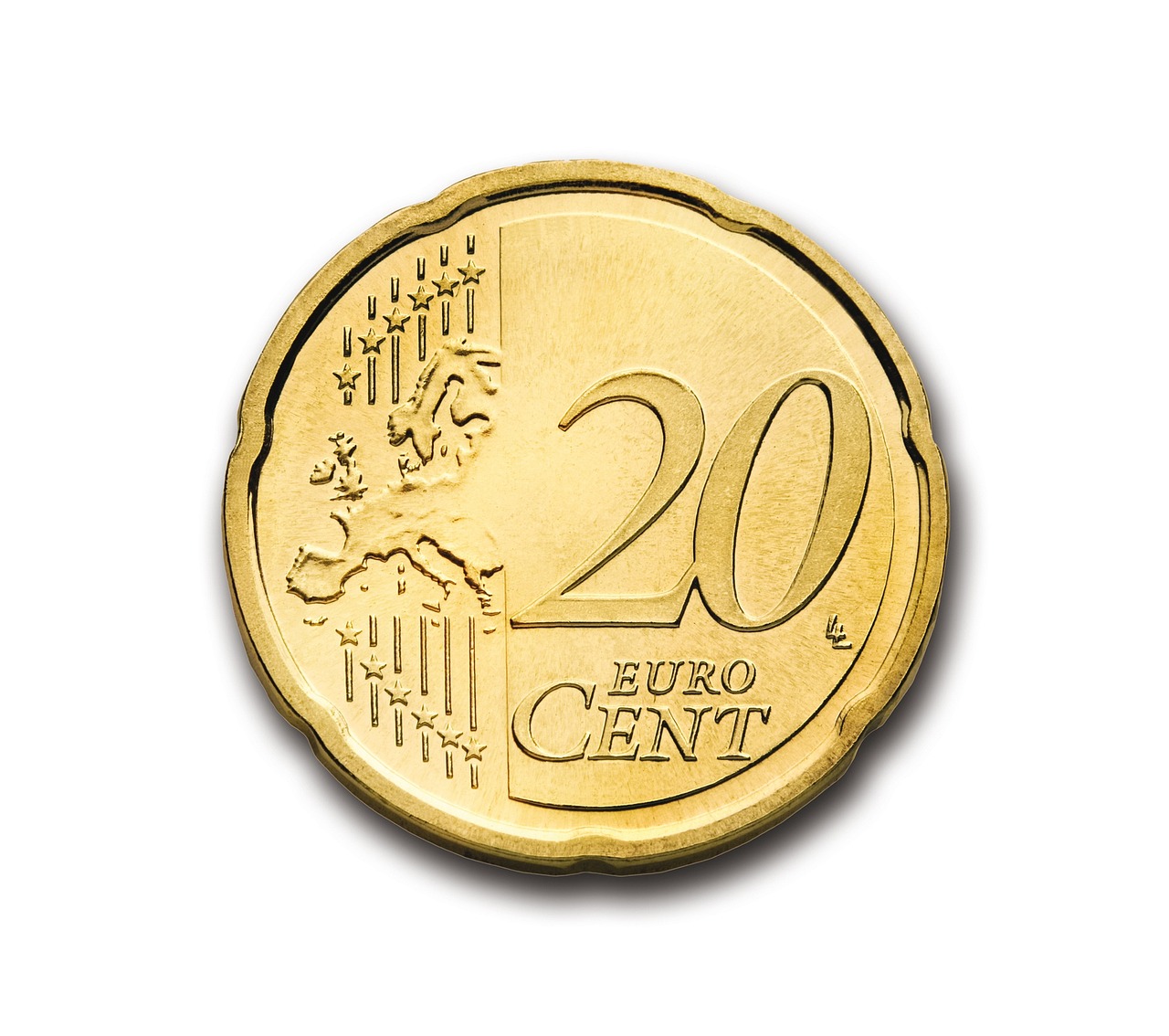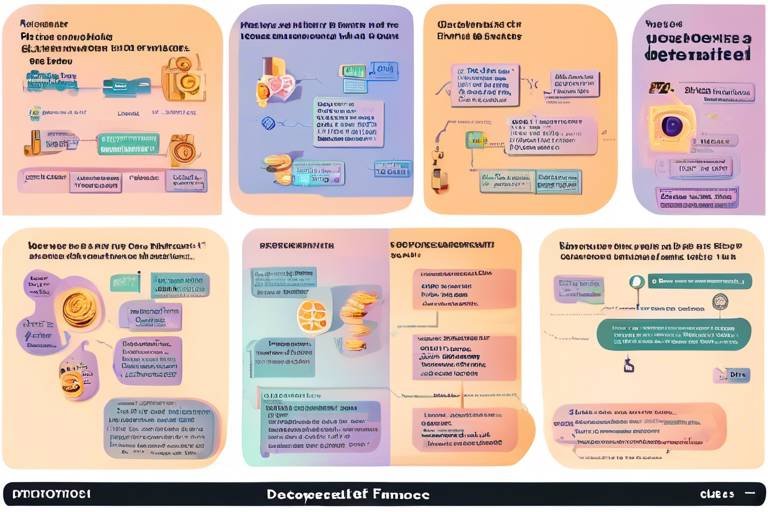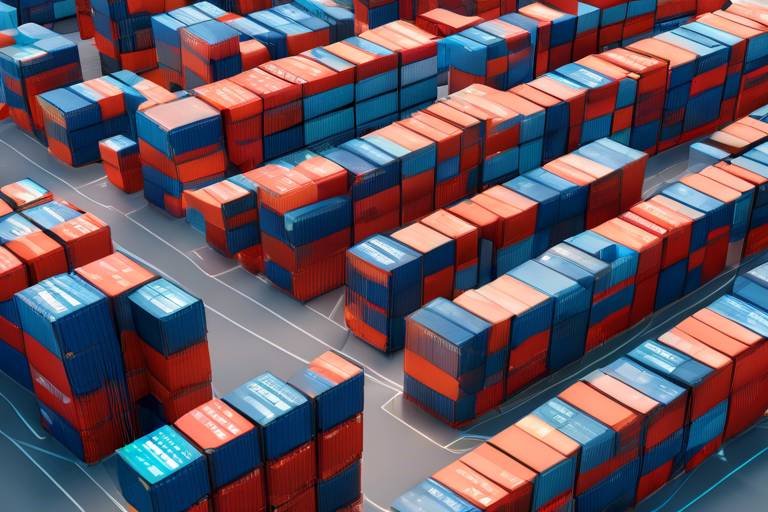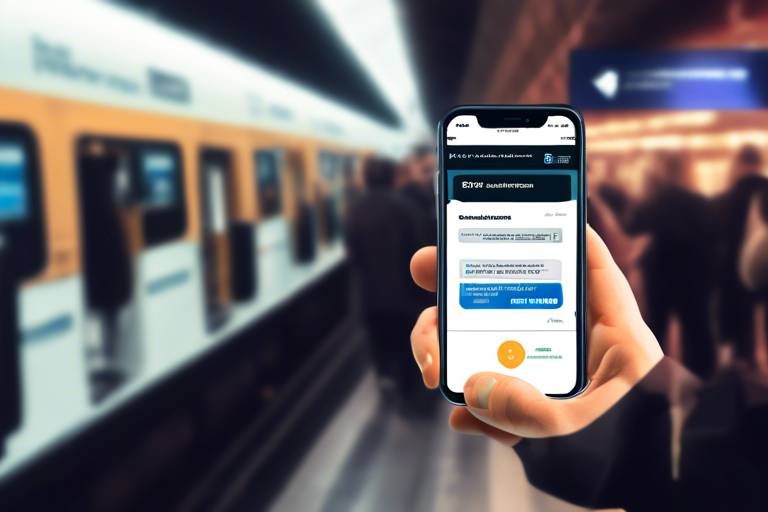Exploring Decentralized Finance (DeFi) and Its Benefits
Welcome to the fascinating world of Decentralized Finance, or DeFi for short! If you’ve ever wondered how technology can shake up traditional finance, you’re in for a treat. DeFi is like a breath of fresh air in a stuffy room, offering a new way to think about money and transactions. Imagine a financial ecosystem where you don’t have to rely on banks or other intermediaries to manage your assets. Sounds intriguing, right? That’s precisely what DeFi aims to achieve - it leverages blockchain technology to create a more transparent, accessible, and efficient financial system.
In this article, we’ll dive deep into the core principles of DeFi, explore its key components, and discuss the myriad benefits it brings to users around the globe. Whether you’re a seasoned investor or just starting your financial journey, understanding DeFi can open up a world of opportunities. So, let’s roll up our sleeves and explore how this revolutionary financial model is changing the game.
At its essence, Decentralized Finance (DeFi) refers to a financial ecosystem built on blockchain technology. This means that instead of relying on traditional financial institutions like banks or brokers, users can conduct financial transactions directly with each other. It’s like having a direct line to your friends without needing a middleman to facilitate the conversation. This model promotes transparency and accessibility in financial services, allowing anyone with an internet connection to participate.
With DeFi, financial services such as lending, borrowing, and trading can be done peer-to-peer, which not only enhances efficiency but also reduces costs. Imagine being able to lend your money to someone across the globe without the hefty fees that banks typically charge. That’s the power of DeFi! It’s a game-changer that aims to democratize finance, making it available to everyone, regardless of their location or financial status.
To truly understand how DeFi operates, it’s crucial to familiarize yourself with its essential elements. Think of these components as the building blocks of a new financial ecosystem. The three key components include smart contracts, decentralized applications (dApps), and liquidity pools. Each plays a vital role in ensuring that the DeFi system runs smoothly and efficiently.
Let’s start with smart contracts. These are self-executing contracts with the terms of the agreement directly written into code. Imagine a vending machine: you put in your money, select your snack, and the machine automatically delivers it. Smart contracts operate on a similar principle, enabling trustless transactions and automating various financial processes within DeFi platforms. They eliminate the need for a middleman, which means transactions can be executed faster and more securely.
The advantages of smart contracts are numerous. They enhance efficiency by automating processes, reduce costs by eliminating intermediaries, and provide a level of security that traditional contracts often lack. In a world where time is money, these benefits can be incredibly valuable.
However, it’s not all sunshine and rainbows. Smart contracts also face challenges, such as coding vulnerabilities and a lack of legal recognition. These issues can pose risks to users and their assets, highlighting the importance of thorough audits and understanding the technology before diving in.
Next up are decentralized applications (dApps). These are applications that run on a decentralized network, providing users with various financial services like lending, borrowing, and trading without relying on central authorities. Think of dApps as the new-age apps that don’t require you to hand over your personal data to a corporate giant. They empower users by giving them control over their assets and financial interactions.
So, why should you care about DeFi? The benefits are plentiful! From increased financial inclusion to lower transaction fees and enhanced user control over assets, DeFi presents a compelling alternative to traditional finance. Let’s break it down:
One of the most significant advantages of DeFi is its potential to promote financial inclusion. By providing access to financial services for the unbanked and underbanked populations, DeFi enables them to participate in the global economy. This is akin to giving someone a key to a door that was previously locked, allowing them to explore new opportunities and improve their financial situation.
Another major benefit is cost efficiency. By eliminating intermediaries, DeFi reduces transaction costs, allowing users to save money and access financial services at lower rates compared to traditional banking systems. Imagine being able to send money across the world for a fraction of the cost it would typically incur – that’s the reality DeFi brings to the table!
- What are the risks associated with DeFi? DeFi can be risky due to smart contract vulnerabilities and market volatility.
- Can anyone use DeFi? Yes! Anyone with an internet connection can access DeFi services.
- How do I get started with DeFi? Start by researching platforms, understanding how they work, and maybe even trying out small transactions.

What is Decentralized Finance (DeFi)?
Decentralized Finance, commonly known as DeFi, represents a groundbreaking shift in how we perceive and interact with financial systems. At its core, DeFi is an ecosystem built on blockchain technology, which allows users to engage in financial transactions without the need for traditional intermediaries like banks or brokers. Imagine a world where you can lend, borrow, or trade assets directly with others, all while enjoying a high level of transparency and security. This is the promise of DeFi.
The beauty of DeFi lies in its ability to democratize access to financial services. By leveraging smart contracts—self-executing contracts with the terms directly written into code—DeFi platforms can automate processes that typically require human intervention. This means that transactions can be executed quickly and efficiently, without the delays often associated with traditional banking systems.
Furthermore, DeFi is not limited to just one type of financial service. It encompasses a wide range of applications, including lending platforms, decentralized exchanges (DEXs), and yield farming protocols. Each of these components plays a crucial role in the broader DeFi landscape, enabling users to take control of their financial destinies.
One of the most exciting aspects of DeFi is its accessibility. Anyone with an internet connection can participate, regardless of their location or financial background. This opens the door for millions of unbanked and underbanked individuals around the globe, allowing them to engage in the global economy like never before. In essence, DeFi is not just a financial revolution; it's a social one, breaking down the barriers that have long kept people from accessing essential financial services.
In summary, DeFi is an innovative financial ecosystem that leverages blockchain technology to provide users with a wide array of financial services without the need for intermediaries. Its core principles of transparency, accessibility, and efficiency make it a compelling alternative to traditional finance, paving the way for a more inclusive financial future.

Key Components of DeFi
Understanding the key components of Decentralized Finance (DeFi) is essential for anyone looking to navigate this revolutionary financial landscape. At its core, DeFi leverages blockchain technology to create a financial ecosystem that operates without the need for traditional intermediaries like banks or brokers. This shift not only enhances accessibility but also democratizes financial services, making them available to a broader audience. The main components that make this possible include smart contracts, decentralized applications (dApps), and liquidity pools.
Smart contracts are the backbone of DeFi, acting as self-executing agreements where the terms are directly written into code. Imagine a vending machine: you put in your money, select your item, and the machine automatically delivers it. Similarly, smart contracts automate transactions, ensuring that once the conditions are met, the agreement is executed without any human intervention. This not only boosts efficiency but also builds trust among users who can rely on the code rather than a third party.
Now, let’s dive deeper into smart contracts. These digital contracts are programmed to execute specific actions when predetermined conditions are met. For instance, in a lending platform, a smart contract can automatically transfer funds from a lender to a borrower once the borrower has provided collateral. This seamless operation reduces the chances of fraud and enhances security. However, it’s crucial to note that while smart contracts are powerful, they are not without their challenges.
One of the most significant advantages of smart contracts is their ability to enhance efficiency. By automating processes, they eliminate the need for intermediaries, which can lead to faster transactions and reduced costs. Additionally, the transparency offered by blockchain technology means that all parties involved can verify the contract's execution, further increasing trust.
However, it's not all sunshine and rainbows. Smart contracts face certain challenges, such as coding vulnerabilities that can be exploited by malicious actors. Furthermore, there is often a lack of legal recognition for these contracts, which can pose risks for users who may find themselves in disputes. It’s essential for users to conduct thorough research and understand the potential pitfalls before engaging with smart contracts.
Next up are decentralized applications (dApps). These applications run on a decentralized network, providing users with a range of financial services, from lending and borrowing to trading and investing. Think of dApps as the modern-day equivalent of your favorite apps, but without the centralized control. They empower users to interact directly with the blockchain, thus enhancing their control over financial transactions.
To better understand dApps, consider the following table that highlights their features:
| Feature | Traditional Apps | dApps |
|---|---|---|
| Control | Centralized | Decentralized |
| Transparency | Limited | High |
| Trust | Requires trust in the provider | Trustless environment |
| Access | Restricted | Open to anyone |
In summary, the key components of DeFi—smart contracts, dApps, and liquidity pools—work together to create an ecosystem that is more efficient, transparent, and accessible than traditional finance. By understanding these elements, users can make informed decisions and take full advantage of the opportunities that DeFi presents.
- What is the main advantage of using DeFi? DeFi provides users with greater control over their assets and reduces reliance on traditional financial institutions.
- Are smart contracts safe? While they offer increased security, smart contracts can be vulnerable to coding errors and hacks, so caution is advised.
- How can I access DeFi services? You can access DeFi services through various platforms that offer decentralized applications, typically by connecting a cryptocurrency wallet.

Smart Contracts
Imagine a world where contracts execute themselves without the need for a middleman. are the backbone of this revolutionary concept within the decentralized finance (DeFi) ecosystem. These are not your typical paper contracts; instead, they are self-executing agreements with the terms of the contract directly written into code. This means that once the predefined conditions are met, the contract automatically performs its function—whether that's transferring funds, issuing tokens, or executing trades—without human intervention. It's like having a digital butler that ensures everything runs smoothly, precisely as you instructed, every single time.
The beauty of smart contracts lies in their trustless nature. In traditional finance, we often rely on banks or legal entities to enforce agreements. With smart contracts, trust is built into the code itself. This automation not only enhances efficiency but also significantly reduces the potential for fraud. Imagine trying to cheat on a contract that is enforced by code—it's nearly impossible! This level of security and reliability is a game-changer for users who are wary of the traditional financial system.
However, as with any technology, there are challenges. Smart contracts can have coding vulnerabilities, which can be exploited by malicious actors. A single bug in the code could lead to significant financial losses. Additionally, the lack of legal recognition in many jurisdictions raises questions about the enforceability of these contracts in case of disputes. To illustrate this, consider the following table that outlines the advantages and challenges of smart contracts:
| Advantages | Challenges |
|---|---|
| Efficiency in transaction execution | Coding vulnerabilities |
| Reduction of costs by eliminating intermediaries | Lack of legal recognition |
| Increased security through automation | Complexity in contract creation |
To wrap it up, smart contracts are not just a fancy tech term; they represent a fundamental shift in how we think about agreements and transactions. They empower users by granting them greater control over their financial interactions while minimizing risks associated with traditional methods. As we continue to explore the DeFi landscape, understanding smart contracts will be crucial for anyone looking to navigate this exciting new world.

Advantages of Smart Contracts
Smart contracts are like the unsung heroes of the decentralized finance (DeFi) world. They bring a level of efficiency and trust that traditional contracts simply can't match. Imagine a world where agreements are executed automatically, without the need for a middleman. That's what smart contracts offer! By embedding the terms of an agreement directly into code, these contracts self-execute when conditions are met. This eliminates the need for intermediaries, which not only speeds up transactions but also significantly reduces costs.
One of the standout advantages of smart contracts is their transparency. Since they operate on a blockchain, every transaction is recorded and can be verified by anyone. This level of visibility helps to build trust among users, as they can see the entire history of a contract's execution. Moreover, the immutability of blockchain technology means that once a smart contract is deployed, it cannot be altered, ensuring that all parties adhere to the agreed terms.
Additionally, smart contracts can be programmed to perform complex operations. For instance, they can facilitate multi-signature transactions, which require multiple approvals before executing, thereby enhancing security. This feature is particularly useful in scenarios where large sums of money are involved or in organizations that require consensus for financial decisions. Furthermore, they can automate recurring payments, such as subscriptions or loan repayments, making life easier for users.
However, it’s essential to acknowledge that while the advantages are compelling, smart contracts are not without their challenges. Users must ensure that the code is thoroughly audited to prevent vulnerabilities, as even a small error can lead to significant financial loss. Despite these challenges, the benefits of smart contracts in the DeFi space are transformative, paving the way for a more efficient and equitable financial system.
- What are smart contracts? Smart contracts are self-executing contracts with the terms of the agreement directly written into code, allowing for trustless transactions.
- How do smart contracts enhance security? They enhance security by eliminating the need for intermediaries and using blockchain technology, which is immutable and transparent.
- Can smart contracts be changed after deployment? No, once deployed, smart contracts cannot be altered, ensuring that all parties adhere to the agreed terms.
- What are the risks associated with smart contracts? Risks include coding vulnerabilities and the lack of legal recognition, which can pose challenges for users.

Challenges of Smart Contracts
While smart contracts offer a revolutionary way to automate transactions and enhance efficiency, they are not without their challenges. One of the most significant issues is the potential for coding vulnerabilities. Just like a poorly written recipe can lead to a disastrous meal, a flaw in the code can result in unintended consequences, including financial loss. Hackers often exploit these vulnerabilities, leading to substantial breaches that can compromise user assets.
Moreover, the lack of legal recognition poses another hurdle. In many jurisdictions, smart contracts may not hold the same legal standing as traditional contracts. This can create uncertainty for users who may find it challenging to resolve disputes or enforce agreements. Imagine trying to argue a case in court with a judge who doesn’t recognize your digital contract—it’s a daunting thought!
Another challenge lies in the complexity of the technology. For the average person, understanding blockchain and smart contracts can be akin to deciphering a foreign language. This complexity can deter potential users, especially those who are not tech-savvy, from fully engaging with DeFi platforms. The learning curve is steep, and without adequate education and resources, many individuals may feel overwhelmed.
Finally, there is the issue of scalability. As more users flock to DeFi platforms, the underlying blockchain networks can become congested, leading to slower transaction times and higher fees. This situation resembles a traffic jam during rush hour—everyone wants to get to their destination, but the road is simply too crowded. If DeFi is to achieve mainstream adoption, addressing scalability issues is crucial.
In summary, while smart contracts are a game-changer in the world of decentralized finance, they come with their own set of challenges. From coding vulnerabilities to legal uncertainties and complexity, users must navigate these issues carefully. As the technology matures, it is hoped that solutions will emerge to mitigate these risks, allowing smart contracts to reach their full potential.
- What are smart contracts? Smart contracts are self-executing contracts with the terms of the agreement directly written into code, allowing for trustless transactions.
- What are the main challenges of smart contracts? The main challenges include coding vulnerabilities, lack of legal recognition, complexity, and scalability issues.
- How do smart contracts enhance efficiency? They automate processes and eliminate the need for intermediaries, making transactions faster and more secure.
- Are smart contracts legally binding? This varies by jurisdiction; in many places, they may not hold the same legal standing as traditional contracts.

Decentralized Applications (dApps)
Decentralized applications, commonly known as dApps, are the backbone of the DeFi ecosystem, representing a significant shift in how we interact with financial services. Unlike traditional applications that run on centralized servers, dApps operate on a decentralized network, typically powered by blockchain technology. This means that there is no single point of failure or control, which enhances security and reliability. Imagine a world where your financial transactions are not governed by a single entity but rather by a network of computers working together; that’s the essence of dApps!
But what exactly can dApps do? The possibilities are vast and varied. They can facilitate a range of financial services, including:
- Lending and Borrowing: Users can lend their assets to others in exchange for interest or borrow assets by providing collateral, all without the need for a bank.
- Trading: dApps enable users to trade cryptocurrencies directly with one another through decentralized exchanges (DEXs), eliminating the need for intermediaries.
- Yield Farming: Users can participate in yield farming by providing liquidity to dApps, earning rewards in the form of interest or tokens.
One of the most appealing aspects of dApps is their ability to empower users with control over their own assets. In traditional finance, users often have to trust banks or financial institutions to manage their money. However, with dApps, users retain ownership of their funds at all times, thanks to the principles of self-custody and transparency that blockchain provides. This shift not only enhances security but also fosters a sense of trust among users, as they can verify transactions and protocols independently.
Moreover, dApps are designed to be open-source, meaning that anyone can inspect the code, contribute to its development, or even create their own version. This collaborative nature encourages innovation and allows for continuous improvement of the services offered. Think of it as a community garden where everyone can plant seeds, and together, they cultivate a thriving ecosystem.
However, it's essential to acknowledge that dApps are not without their challenges. The user experience can often be complicated for those unfamiliar with blockchain technology. Issues such as high gas fees during peak usage times and slow transaction speeds can deter potential users. Additionally, the lack of regulatory clarity around dApps raises questions about their long-term viability and security.
In summary, decentralized applications (dApps) are revolutionizing the financial landscape by providing innovative solutions that prioritize user control, security, and transparency. They are not just a trend; they represent a fundamental shift in how we think about and interact with financial services. As the DeFi space continues to evolve, dApps will undoubtedly play a crucial role in shaping the future of finance.
What are dApps?
dApps, or decentralized applications, are applications that run on a decentralized network, allowing users to engage in various financial services without relying on central authorities.
How do dApps ensure security?
dApps use blockchain technology, which provides a secure and transparent environment for transactions, eliminating the need for intermediaries and reducing the risk of fraud.
Can anyone create a dApp?
Yes! dApps are typically open-source, meaning that anyone with the necessary skills can create, modify, or contribute to them.
What are the main challenges of using dApps?
Some challenges include a complicated user experience for newcomers, high transaction fees during peak times, and regulatory uncertainties.

Benefits of DeFi
Decentralized Finance, or DeFi, is not just a buzzword; it's a game-changer in the financial landscape. One of the most significant benefits of DeFi is its ability to increase financial inclusion. Imagine a world where everyone, regardless of their location or financial status, has access to financial services. DeFi makes this dream a reality by providing tools that allow the unbanked and underbanked populations to participate in the global economy. No longer do people need to rely on traditional banks, which often impose strict requirements and high fees. Instead, they can access essential financial services through their smartphones, breaking down barriers that have existed for decades.
Another remarkable advantage of DeFi is cost efficiency. Traditional financial systems are often laden with fees due to the presence of intermediaries, such as banks and brokers. DeFi eliminates these middlemen, allowing users to save on transaction costs. For instance, when you lend or borrow through a DeFi platform, you can do so at rates significantly lower than those offered by conventional banks. This not only saves money but also encourages more people to engage in financial activities, further stimulating economic growth.
Moreover, DeFi enhances user control over assets. In a traditional banking system, you trust a bank to manage your money, but with DeFi, you have complete control. Your assets are stored in your digital wallet, and you decide how and when to use them. This shift from custodial to non-custodial systems empowers users, giving them the freedom to manage their finances without the fear of arbitrary restrictions or sudden policy changes imposed by banks.
To illustrate the benefits of DeFi, consider the following table that compares traditional finance with DeFi:
| Feature | Traditional Finance | Decentralized Finance (DeFi) |
|---|---|---|
| Access | Limited to banked individuals | Open to anyone with internet access |
| Transaction Fees | High fees due to intermediaries | Lower fees with no intermediaries |
| User Control | Bank controls user assets | User retains full control of assets |
| Speed of Transactions | Slower due to processing times | Faster, often instant transactions |
In addition to these benefits, DeFi also fosters transparency. All transactions are recorded on the blockchain, which is accessible to anyone. This transparency builds trust among users, as they can verify transactions independently without relying on a central authority. Furthermore, the innovative nature of DeFi encourages financial innovation. New products and services are continuously being developed, from yield farming to decentralized exchanges, providing users with a plethora of options to manage and grow their wealth.
In conclusion, the advantages of DeFi are transformative. By promoting financial inclusion, reducing costs, enhancing user control, ensuring transparency, and fostering innovation, DeFi is paving the way for a more equitable financial system. The question is, are you ready to embrace this revolution?
- What is DeFi? DeFi, or Decentralized Finance, refers to a financial ecosystem built on blockchain technology that allows users to conduct financial transactions without intermediaries.
- How does DeFi promote financial inclusion? By providing access to financial services for the unbanked and underbanked populations, allowing them to participate in the global economy.
- Are DeFi transactions secure? While DeFi offers security through blockchain technology, users must be cautious of smart contract vulnerabilities and ensure they use reputable platforms.

Financial Inclusion
Imagine a world where everyone, regardless of their background or location, has access to financial services. This is the vision that Decentralized Finance (DeFi) champions, breaking down the barriers that have historically left many people outside the financial system. Financial inclusion is not just a buzzword; it’s a crucial component of economic empowerment. By leveraging blockchain technology, DeFi opens doors for the unbanked and underbanked populations, allowing them to engage in the global economy.
In many developing regions, traditional banking systems are either nonexistent or too complicated for the average person to navigate. DeFi steps in as a game-changer, providing a seamless and user-friendly interface for financial transactions. With just a smartphone and internet access, individuals can tap into a wealth of services, from lending and borrowing to trading and investing. This democratization of finance is akin to giving a key to a locked door—once it’s opened, a world of opportunities unfolds.
One of the most compelling aspects of DeFi is its ability to reach those who have been traditionally marginalized. According to recent studies, over 1.7 billion adults worldwide remain unbanked, meaning they lack access to basic financial services. DeFi can bridge this gap by offering:
- Accessibility: Users can access financial services anytime, anywhere, without the need for a physical bank branch.
- Lower Barriers to Entry: With minimal requirements, individuals can start participating in financial activities without hefty fees or complex procedures.
- Empowerment: DeFi provides users with control over their assets, enabling them to make decisions without relying on intermediaries.
Furthermore, DeFi platforms often utilize stablecoins—cryptocurrencies designed to maintain a stable value—making transactions less volatile and more predictable. This stability is crucial for individuals in developing countries where local currencies may fluctuate dramatically. By using stablecoins, users can save, transact, and invest with confidence, knowing their wealth won’t evaporate overnight.
In conclusion, the potential for financial inclusion through DeFi is immense. It’s not merely about providing services; it’s about transforming lives. The ability for individuals to access financial tools can lead to better economic opportunities, improved living standards, and overall community development. As we continue to explore the capabilities of decentralized finance, it’s clear that it holds the promise of creating a more equitable financial landscape for everyone.
1. What is financial inclusion?
Financial inclusion refers to the accessibility and availability of financial services to all individuals, particularly those who are underserved or excluded from traditional banking systems.
2. How does DeFi contribute to financial inclusion?
DeFi eliminates intermediaries, reduces costs, and provides accessible financial services through blockchain technology, allowing unbanked individuals to participate in the economy.
3. Can anyone use DeFi services?
Yes, as long as individuals have access to the internet and a compatible device, they can engage with DeFi platforms without needing a bank account.
4. What are stablecoins?
Stablecoins are cryptocurrencies designed to maintain a stable value, often pegged to a fiat currency, which helps mitigate the volatility typically associated with cryptocurrencies.
5. Are there risks associated with DeFi?
While DeFi offers many benefits, it also comes with risks such as smart contract vulnerabilities and lack of regulatory oversight. Users should conduct thorough research before participating.

Cost Efficiency
When we talk about in the realm of decentralized finance (DeFi), we are diving into a transformative aspect that can change how we view money management. Traditional financial systems often come with a myriad of fees—think bank charges, transfer fees, and commissions that seem to multiply like rabbits. But with DeFi, the narrative shifts dramatically. By leveraging blockchain technology, DeFi platforms eliminate the need for intermediaries, which is where the bulk of these costs typically arise. Imagine being able to send money across the globe without paying hefty fees to banks or payment processors; that’s the beauty of DeFi!
In a traditional banking scenario, you might encounter various fees such as:
- Account maintenance fees
- Transaction fees for wire transfers
- Currency conversion fees
- ATM withdrawal fees
In contrast, DeFi platforms often operate with minimal fees or even none at all. This is largely because transactions are peer-to-peer, meaning they occur directly between users without the need for a middleman. This not only speeds up the process but also keeps costs down. For instance, many DeFi applications utilize liquidity pools, where users can lend their assets and earn interest, all while keeping transaction costs low.
To illustrate this point further, let’s consider a comparison of transaction costs between traditional finance and DeFi:
| Service | Traditional Finance Cost | DeFi Cost |
|---|---|---|
| International Wire Transfer | $25 - $50 | $1 - $5 |
| Currency Conversion | 3% - 5% | 0.5% - 1% |
| Lending Fees | 2% - 5% | 0.1% - 1% |
As shown in the table above, the cost differences are significant. This reduction in fees not only benefits individual users but also encourages more people to engage with financial services. When financial transactions are more affordable, it opens the door for those who previously may have been excluded due to high costs. In essence, DeFi is democratizing finance by making it accessible and affordable for everyone, regardless of their financial background.
Moreover, the of DeFi enhances user control. Users can choose the services they want to engage with, often with the ability to customize their transactions and fees. This level of autonomy is a game-changer compared to traditional banking, where users often feel trapped by rigid structures and opaque fee systems. In DeFi, users can take charge of their financial destiny, making choices that suit their needs without the burden of excessive costs.
Q: What makes DeFi more cost-efficient than traditional finance?
A: DeFi eliminates intermediaries, which reduces transaction fees. Users can engage in peer-to-peer transactions directly, keeping costs low.
Q: Are there any hidden fees in DeFi?
A: While many DeFi platforms promote low or no fees, users should always review the terms and conditions, as some platforms may charge fees for specific services.
Q: Can I trust DeFi platforms with my money?
A: Trust in DeFi comes from the transparency of blockchain technology. However, it’s crucial to conduct thorough research on any platform before investing.
Q: How can I start using DeFi?
A: To start using DeFi, you’ll need a digital wallet and some cryptocurrency. From there, you can explore various DeFi platforms that suit your financial needs.
Frequently Asked Questions
- What is the primary purpose of Decentralized Finance (DeFi)?
The primary purpose of DeFi is to create an open financial system that operates without intermediaries. This means anyone can access financial services like lending, borrowing, and trading without needing a traditional bank or financial institution. It promotes greater transparency and accessibility for users around the world.
- How do smart contracts work in DeFi?
Smart contracts are self-executing contracts with the terms written directly into code. They automatically enforce and execute agreements when certain conditions are met. This eliminates the need for a middleman, making transactions faster and more secure. Think of them like vending machines that dispense products automatically when you insert the correct amount of money.
- What are decentralized applications (dApps)?
dApps are applications that run on a decentralized network, typically utilizing blockchain technology. They provide various financial services without relying on a central authority. This allows users to engage in activities like lending, borrowing, and trading in a more secure and transparent environment.
- How does DeFi promote financial inclusion?
DeFi promotes financial inclusion by providing access to financial services for individuals who are unbanked or underbanked. It allows anyone with an internet connection to participate in the global economy, breaking down barriers that traditional banking systems often impose.
- What are the risks associated with using DeFi?
While DeFi offers many benefits, it also comes with risks. These include smart contract vulnerabilities, regulatory uncertainties, and the potential for market volatility. Users should conduct thorough research and exercise caution when engaging with DeFi platforms.
- Can I earn interest on my assets in DeFi?
Yes! Many DeFi platforms allow users to earn interest on their assets by lending them out or providing liquidity to pools. This can often yield higher returns compared to traditional savings accounts, but it’s essential to understand the associated risks.
- Are transaction fees lower in DeFi compared to traditional finance?
Generally, yes! DeFi often eliminates intermediaries, which can lead to lower transaction fees. However, fees can vary based on network congestion and the specific platform used, so it's wise to check before making transactions.



















